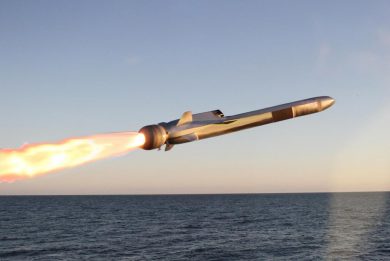IDEX 2025 – EDGE and Milrem Robotics unveil their Havoc 8×8 unmanned ground vehicle
At the Abu Dhabi exhibition Milrem Robotics, the Estonian company which majority stake was acquired in 2023 by EDGE, unveiled its 8×8 unmanned ground vehicle (UGV) named Havoc, which mock-up starred in the group stand
Well known for its combat proven THeMIS 6×6 UGV, which was also selected as a primary platform for the first iteration of the European iMUGS programme, and for its Type-X tracked heavy combat UGV, Milrem Robotics unveiled a new heavy combat vehicle, switching from tracks to wheels. “We consider that tracks are appropriate for the European scenario, especially in northern European countries, while we think that for the Middle East a wheeled platform better suits local requirements,” a company source told EDR On-Line. Hence the development of the 8×8 Havoc, for which Milrem Robotics teamed with an automotive specialist, Timoney of Ireland. A four-axle hybrid propulsion platform, the Havoc automotive platform is based on Timoney T-900e electric powertrains, each rated for 9,500 kg mass.
Why having four 9.5 t axles for a vehicle which kerb mass is around 15 t to which we must add a payload up to 5 t, which means less than half the potential 38 t provided by the Timoney solution? Having eight 16.00R20 tires on the ground means a considerable contact surface, hence a low specific pressure, plus considerable traction, something definitely positive when we consider that Milrem aims its new 8×8 Havoc to Middle East countries, typically sand desert scenarios. Independent double wishbone suspensions with hydropneumatics shock absorbers ensure optimal travel on difficult terrain, while the all-wheel steering permits pivot steering, normal turning radius being 10 metres.
Each axle has a peak output power of 280 hp, which makes a total of 1,120 hp, electric motors working at 650 V. Motors are powered by diesel-reloaded batteries and are linked via an electric clutch to a 3-speed gearbox. The total output power provides the 17 tonnes GVW vehicle with a 56 hp/t power to mass ratio, a much higher figure compared to most armoured wheeled vehicles, a guarantee for mobility performances. Yes, armoured, because the Havoc has a Level 3 protection ballistic (some sources give a Level 4 figure) and a Level 1 protection against mines and blast, ground clearance being 440 mm; protecting an unmanned vehicle might seem useless, however this considerably enhances its survivability, hence the capacity to carry on fight even when confronted with small arms fire; according to STANAG 4569 Level 3 means protection against 7.62×51 mm armour piercing rounds from 30 metres distance and a 155 mm high explosive artillery projectile detonating at 60 metres distance, these figures becoming 14.5×114 mm rounds from 200 metres and 155 mm at 30 metres.
The Havoc is 6.5 metres long, 2.8 metres wide, and can reach a maximum speed on road of 110 km/h, which become 50 km/h when moving cross country, range being 600 km at cruise speed. It can climb a 60% ramp, move on a 40% side slope, overcome a 600 mm step, and ford a 1-metre-deep water obstacle.
At IDEX 2025 the Havoc 8×8 mock-up was shown fitted with a turret armed with a 30 mm cannon and with a three-tube launcher for the Frankenburg Technologies Mk1 surface-to-air mini missile; in this configuration heigh to turret roof is 2.7 metres. According to data provided by the Estonian company these missiles carry a 400 grams warhead, have a range of over 2 km, and can reach an altitude of 1,500 metres; kill probability is 70% against targets with a mass of less than 150 kg flying at a speed under 200 km/h. The turret was also fitted with a Pilar V gunshot detector by Metravib of France, and with a Vegvisir mixed reality-based 360° situational awareness system.
The one seen at IDEX was only one of the many payload options proposed. Another turret that can easily be installed is the Kongsberg MTC-30, which was already fitted to Milrem’s Type-X prototype. The platform can become an indirect fire asset, hosting a quadruple launcher for Halcon HS-2 loitering munitions, Halcon also being part of EDGE, another solution seen on viewgraphs being KNDS Deutschland Skorpion 2 mine scattering system, four launchers being seen in an image, that system having already been installed on the Type-X exhibited at Eurosatory 2024. The 5 tonnes payload capacity leaves however a lot of options to customers.
EDR On-Line understood that the development of the Havoc is currently being completed, and a prototype will be created by the end of 2025, which will undergo testing in 2026-2027. The delivery of the first combat platform to the UAE is planned for 2028.
On the other hand, a tracked version of the Havoc, known as Vector, is already in the pipeline, no timeline being provided yet. According to data available this will weigh 14.5 tonnes without payload, the latter being 3 tonnes. Also, a hybrid-electric vehicle, it will be marginally wider and its maximum speed on road will be of 80 km/h, cross-country speed remaining the same.
Photos courtesy N. Novichkov, P. Valpolini and Timoney









